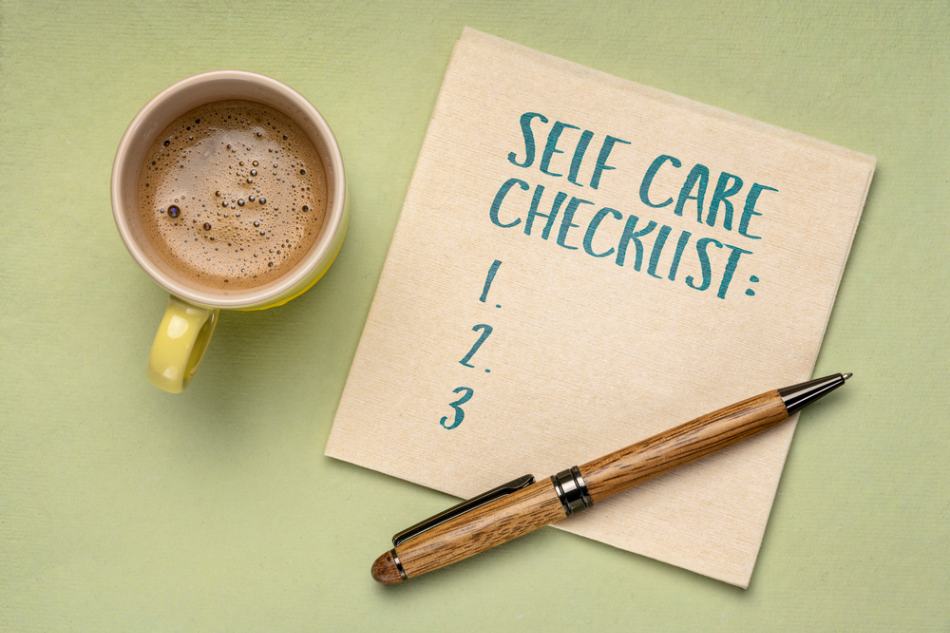August 11, 2022
Webinar: An Introduction to Career Counseling
Written by Rachel Eddins
Posted in Career Planning, Webinars and with tags: career, career change, career direction

Learn more about career counseling, how to find career direction, and manage your career.
The world of careers is changing. Here you will learn the old models, what has changed, as well as the new models and how to use them.
This webinar is facilitated by Joan Mullinax, a Licensed Professional Counselor.
Watch a replay of the presentation here.
Learn more about our Career Counseling Services.
Here is a transcript of the webinar:
Hi, I’m Joan Mullinax and I’m a career and personal counselor with Eddins Counseling Group I want to welcome you to this presentation. I’ve been doing career counseling for almost 15 years now.
Agenda
The agenda for what we’re talking about tonight is career counseling:
- The world of careers is changing
- The old model
- What has changed
- A new model (one of many)
- Using the new model
- Questions
We’re going to spend the bulk of the time talking about using the new model.
Career Counseling: The Career Ladder

The beginning of my career was long enough ago that this was actually the model. At the time that I started my career, it changed in the middle and this is getting increasingly rare in this model of the career ladder.
Let me describe what that looks like. In the past, the entire career was the same.
You started out at entry-level, you climbed the ladder, and then you retired. You got your gold watch and they sent you off with a festive party.
Or, said differently, you started with one company at the entry-level and worked there until retirement.
That is getting more rare than climbing a ladder in the same career.
What Has Changed?
So what’s changed?
Careers are changing. There’s been a rapid change in technology and it’s an ongoing change in technology. The rate at which new knowledge is being generated is faster than at any time in history.
Basically every year we’re creating as much new knowledge as existed in the entire previous history of mankind.
Careers are increasingly specialized. Some careers are declining or even disappearing. This points to the necessity of updating your knowledge and skills on an ongoing basis.
You can’t just hang around and be comfortable with what you already knew. Because if you do, the world will move underneath you and you’ll suddenly discover that you don’t have any solid ground to stand on.
Jobs are also changing. So company loyalty to employees is less common.
In fact, it’s not uncommon these days for people who are on the verge of retirement to suddenly be seen as too expensive and high overhead. All of a sudden, they may be asked to retire, and in some cases, right before their retirement benefits kick in.
So you can see what has happened to loyalty in that scenario.
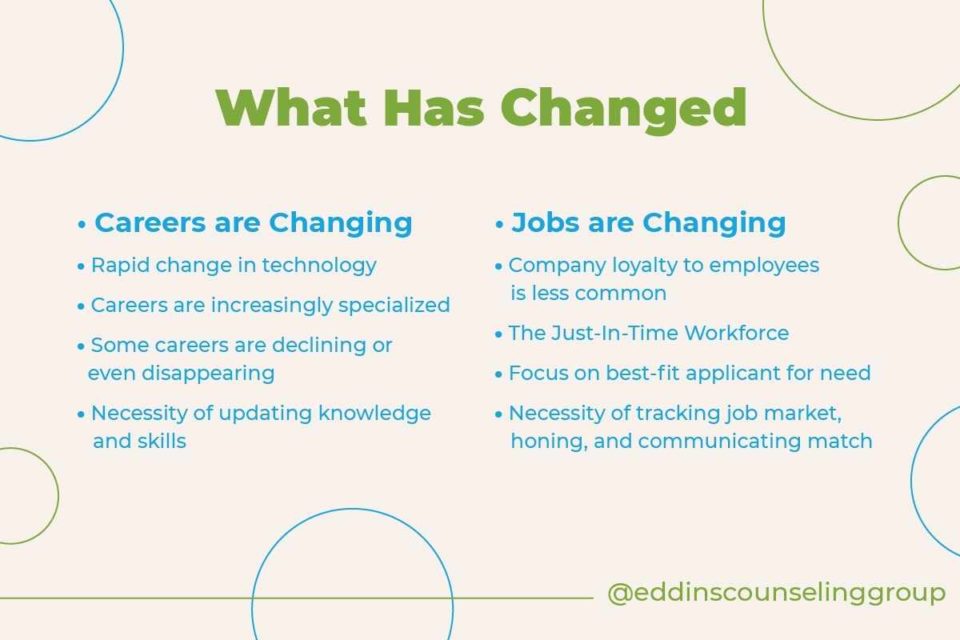
Just-In-Time Workforce
There’s also something that’s called the Just-In-Time Workforce. So it’s like, I don’t need 1,000 people right now. I need 80 people for this project, 70 people for this project, and 90 people for this project.
Maybe sometime during the process, with all the projects we have going on, it will add up to 1,000 people. But then some projects will fall off and companies are more likely to be using contract employees, so they end their contracts and the people go on and pick up work for other companies.
So you bring in the workforce just in time that you need it, and then you let it go when you’re done.
The Hiring Process: Hiring Bonuses and Layoffs
Right now, what’s happening is that the hiring process is actually booming for people with knowledge and skills. There’s a lot of hiring going on, but one of the things that is going on is that employers, rather than maybe necessarily commit to a long-term employee, they’re offering bonuses to bring people in, and then if they have to let them go, then that money then drops away as an expense for them.
Best-Fit Applicants
Also, the qualifications for a given occupation, or for a given job posting, are very frequently focused on best-fit applicants for the needs that they posted.
So you can come in and have 90% of the qualifications and you may get an interview, and yet you won’t get the job because you met 90% and they found somebody who met 95% or 98%.
Sometimes you have to refresh your knowledge to match what the postings are so that you’re able to make yourself the best-fit person for the job.
It’s really essential for you to track the job market in the area that you work in, notice whether it’s growing, shrinking, or flattening out. Then, hone your skills and your knowledge and communicate your match to the requirements.
Containerized Transportation
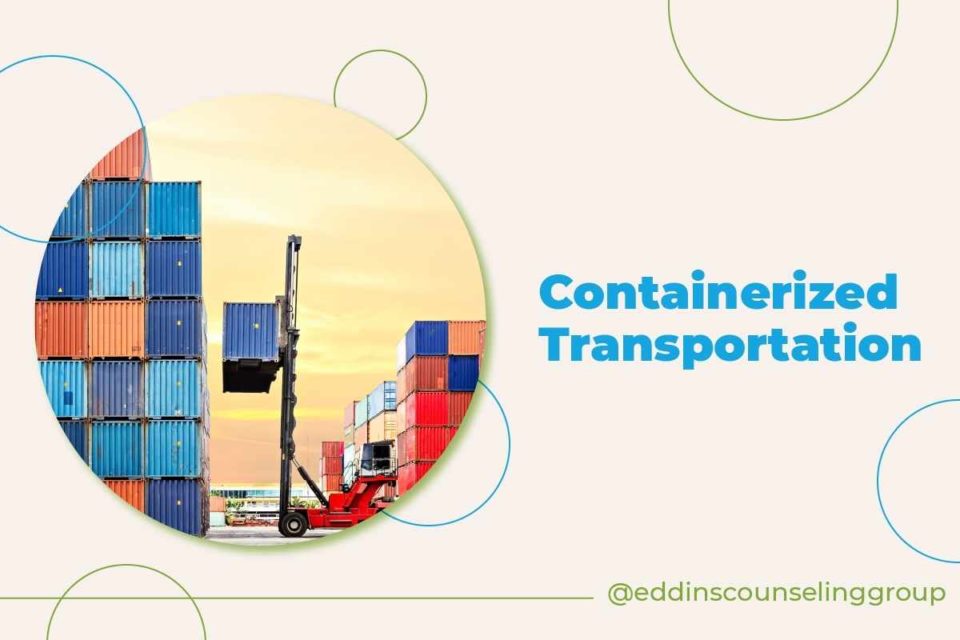 I’ve used some really fairly old examples here in terms of transitions and in terms of careers. But these are obvious kinds of transitions, whereas the transitions in computer technology are a little hard to show on a slide and make them make sense.
I’ve used some really fairly old examples here in terms of transitions and in terms of careers. But these are obvious kinds of transitions, whereas the transitions in computer technology are a little hard to show on a slide and make them make sense.
When I was in high school, there was this massive strike at the Houston Ship Channel against containerized shipping. So there were stevedores (a dockworker) that worked on the docks, and they loaded things by boxes, one box at a time, filling up the cargo holes with the boxes, and then going back to the dock to get more boxes. And that’s not what’s happening anymore.
So what we’ve got instead are these box car-size containers. And you’ll notice that this is a semi-truck here. Then we’ve got basically a heavy-duty forklift.
So you’ve got a forklift driver and you’ve got a truck driver, and you’ll notice, at least in this picture, those are the only two people on the dock. Now, obviously, this is for a picture that there’s nothing else happening on this dock except for loading this one particular container.
This is a container that’s probably come in on a ship. It’s being loaded on a truck to be transported locally. Or this could be being removed from the truck to be transported onto a container ship, where they pile the containers stunningly high on the ships. So there is a big transition here.
The skill factors are a big transition as well and people lost their jobs over this.
Typing Jobs Declining
Here’s another one. Typing jobs, where it’s like a clerk type and this nice neat desk, that all I’ve got to do is my typing stuff and answer the phone. Those jobs are beginning to decline, and now everybody is doing their own typing.
So you’ll notice here, this person has got a nice thick book. They’ve got a pen that they’re writing on a pad of paper for something that’s not text-based, and then they’re typing with their other hand.
Manufacturing Automation
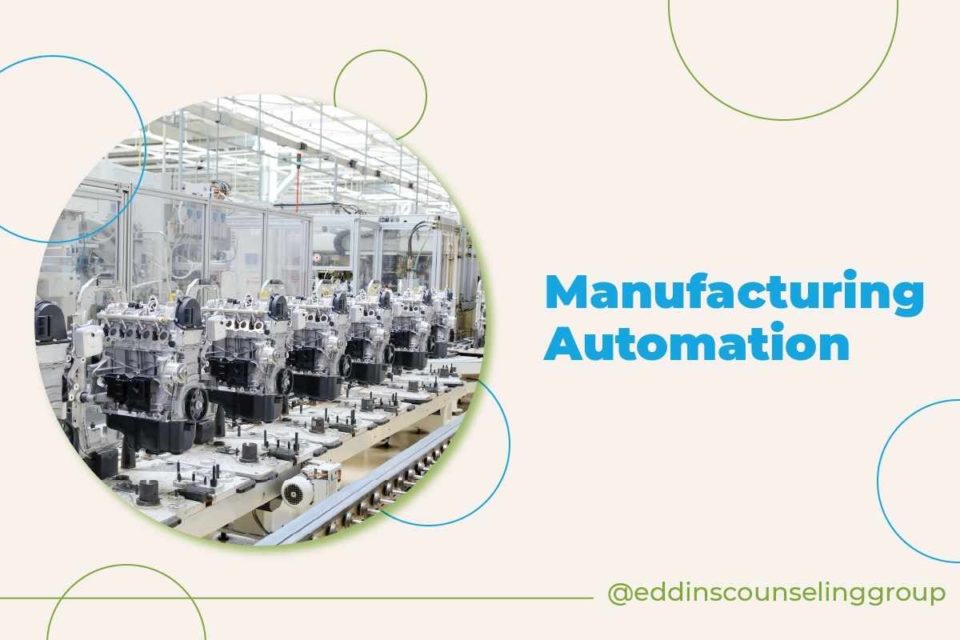 Here you’ve got some specialized factory construction where you have specialized people constructing this very unique and specific device. When you get into the situation where what’s being built is a standard product, you start getting into automated factories.
Here you’ve got some specialized factory construction where you have specialized people constructing this very unique and specific device. When you get into the situation where what’s being built is a standard product, you start getting into automated factories.
You’ll notice there are no human beings in this picture of the factory. Now there are human beings in the factory. They are programming the automated equipment. They are monitoring the automated line flow, and they are identifying problems and solving problems.
But you’ll notice that once again, the skill level has gone up in order to maintain a job, even in a manufacturing environment.
Now, there are small companies that may be doing things more from a manual perspective, but certainly, in large companies, automated manufacturing has really taken off.
Career Development Cycle
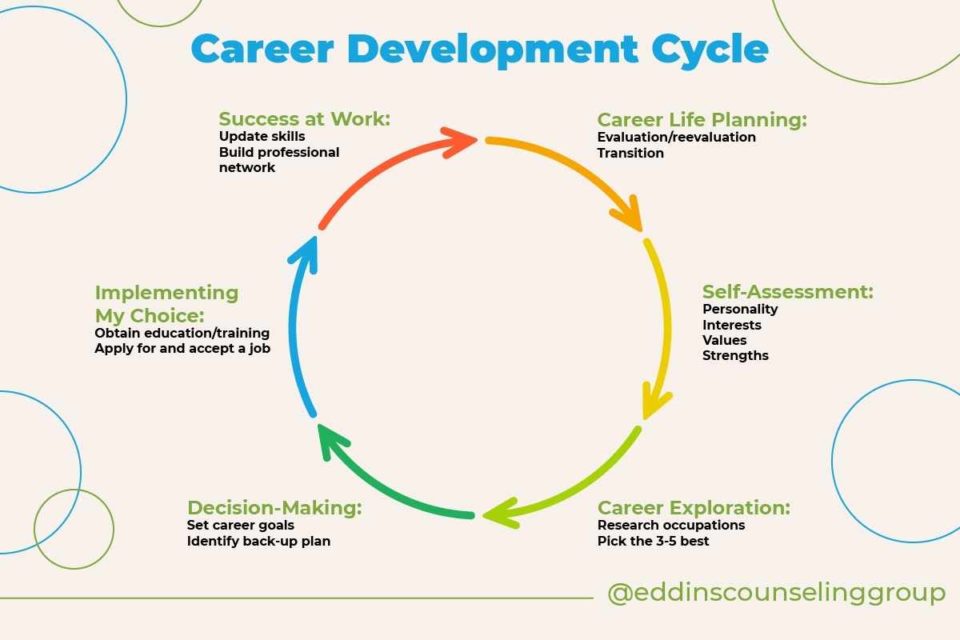
What do we need to do about this? So our career ladder doesn’t work anymore in this kind of scenario because it’s a moving target. What we’ve got here is the career development cycle.
I personally have gone around this cycle about three times since I graduated from college with a degree in computer science and worked for 15 years in new product development in the computer industry at Compaq, now known as HP.
Then at some point, that career ended and I started teaching computers at the community college. So, career number two, using my existing skills and then adding some additional skills to go with it.
Of course, I’d already done a lot of training and things like that while I was in the computer industry. So that was a pretty good fit.
And then another transition.
Now I do career counseling, I’m a career counselor and a personal counselor. And this required significant new training for me to get the state certification as a licensed professional counselor.
You can go around this Career Development Cycle wheel multiple times.
Most people show up in my office here in the upper right-hand corner where they’re doing career or life planning. They’re doing some kind of evaluation or reevaluation and they’re considering making a transition.
This is basically the outline we’re following:
- Career/life planning
- Self-assessments
- Career exploration
- Decision-making
- Implementing your choice
- Success at work
Then you may end up back at the starting point again.
Career/Life Planning
-
Internal Factors
Career life planning means evaluation or reevaluation considering making a transition.
Factors that may be driving the evaluation or reevaluation include internal factors – I want more of this and less of this, I want to do less product development and more people development.
That was a key transition for me.
-
External Factors
External – COVID is a perfect example of an external career factor.
It drove some people out of their jobs and drove some people into their homes to work. But it definitely changed the rules of the game as far as the job market was concerned.
-
Career Development
Career development is also a factor that can drive reevaluation- what do I want my next steps to look like?
A kind of prototypical example of this would be somebody who is trained as a bachelor’s in engineering and they’re trying to decide whether they want to grow on the technical path or whether they want to maybe get an MBA and transition to the management path.
That’s kind of a signature case of “what I want my next step to look like in my career”.
-
Life Phase Issues
This also can be affected by life phase issues. I’ve included a very short list here. In truth, the list is much longer than this.
It could include a serious relationship, getting married, having kids, kids starting school, kids starting college, or kids ending college.
These days even retirement is frequently a career event because people my age, we’re not ready to quit, we’re having too much fun.
One of the things that I do is support people who are transitioning out of a current career and looking at what they want their retirement career to look like because otherwise, it can be very risky to your health not to have a good plan to keep you engaged in life after you retire.
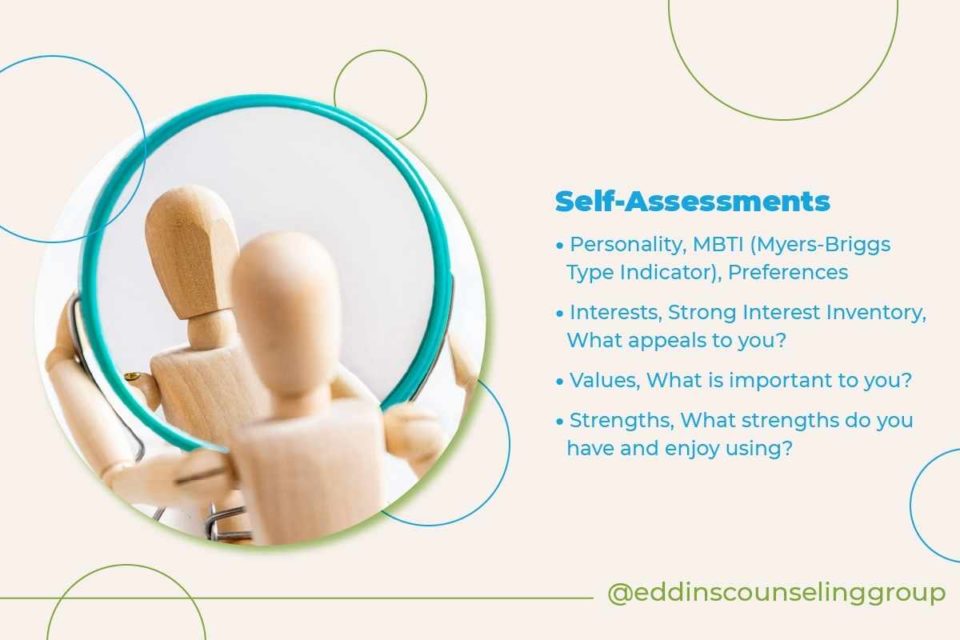
Self-Assessment
The self-assessment starts with personality. And we’re using the Myers-Briggs Type Indicator, and this focuses on your preferences:
- Where do you prefer to focus your attention and get energy?
- How do you prefer to take information?
- How do you prefer to make decisions?
- How do you prefer to orient yourself toward the external world?
Personality
You may have encountered versions of these freebies on the internet that you’ll come up with “One of 16 personality types”. I use not only the real Myers Briggs, but I use the advanced real Myers Briggs, which tells you not only the 16 personality types you have but also individual differences in types.
So we get a very much richer picture from the advanced MBTI than you get from the freebie ones.
Interests
The next one is Interests. We use a Strong Interest Inventory, and that’s about what appeals to you. The Myers-Briggs, depending on how clear your preferences are, your assessment may be fairly stable over time.
So the first time I took the Myers-Briggs, I was probably in my forties and it’s never changed. I’ve taken it about three or four times since then, and I’m the same four letters every time because it was taken at a time when I knew who I was, and that hasn’t altered dramatically since then.
The Strong Interest Inventory is much more volatile and much more likely to change over time depending on what you’ve been exposed to or how the world is changing.
This is about what appeals to you. You may see something on television or online or even in the job that you currently work in, and you go: “Oh my gosh, that sounds like fun. I think I’d really enjoy doing that.”
So we’re very interested in having you be in a job that suits you and that going to work feels like you’re going home to work. And if you look at your schedule for the day, you don’t feel frustrated. Instead, you are excited and happy.

Values and Strengths
The next one is values, which are what is important to you, and the last one is strengths. We’re especially focused on strengths you enjoy using because a recipe for burnout is using strengths you don’t enjoy.
When I started working on my bachelor’s degree in computer science, I did not have a good career counselor to let me know I will get depressed every time I look at going into the computer industry. So I merrily went into the computer industry.
I soothed my depression by saying: “I don’t plan to stay in this forever”.
I did end up staying 15 years and I was never bored except for about 30 seconds one morning and went: what is this strange feeling? And I went: “Oh, it’s boredom.” And then it went away.
So I wasn’t bored, but it was not a good match. I’m a personality type for counseling and I was pretty much of an odd duck in the computer industry. I’m going to talk more about these self-assessments.

Career Development Factors
Here we look at personality, interests, values, and strengths.
This is a lovely idealized model where they all overlap, and there’s a sweet spot in the middle where you are going to attain career heaven.
Sometimes it’s not so symmetric as this, and three of them overlap and one of them doesn’t, or two of them overlap and two of them don’t. But if you think of a career as life’s work, it can include what you do for a living, family and friends, hobbies, or volunteer work.
You can put together a cluster of activities that fully expresses who you are in the world, which is really what you want to be doing anyway. Finding a way to express yourself in the things that you do with your time.
Your Work Environment
This also can tell us about what kind of work environment. It can be as simple as indoors versus outdoors, sitting at a desk, up and moving around, working alone, working with other people, competitive environments, and cooperative environments.
It does not tell you about toxic environments because toxic is toxic. One of the things I do in my job is help people either make some adjustments in their toxic environments by some appropriate communication or find another environment that’s not toxic and how to identify an environment that’s toxic before you go into it.
Career Exploration and Decision-Making
The next step in our circle is career exploration and decision-making. With the career exploration part, you can research occupations. We’ve got a couple of labor websites. So one is CareerOneStop, or you can visit O*Net.
One of the challenges about doing the Myers-Briggs, one of their assets of them is that they will give you a list of dozens of occupations to explore. So there are over 30,000 occupations. It’s going to give you dozens to look at. It’s eliminated a lot of them so you wouldn’t be interested in these at all. And sometimes entire categories of jobs are eliminated.
You’ve now got to narrow that down. So if you go to career counseling and talk to a career counselor, they can help you manage the information overload that can happen in this process so that you can emerge from this exploration process with three to five of the best options.
The next step that it shows on the chart is decision making and it includes setting your career goals and identifying a backup plan.
How to Get from (3 to 5) to (Plan A and Plan B)?
Here we’re going to talk about informational interviewing.
Informational interviewing is where you arrange to speak with people who work in the kind of field that you are interested in and you interview them things like:
- What do they do on a particular day?
- What a particular week looks like?
- How did they get established in this career?
- What do they like about it?
- What do they not like about it?
This is another one that I think is really valuable to actually talk to a career counselor about because it’s a powerful process, but it takes the right tools and the right perspective, and there are some subtleties to it that can make it work better if you actually get trained in it.
I had the good fortune of being trained in that when I made my transition out of the computer industry.
Implementing Your Choice
The education or training can range depending on what point you’re at: completing high school, getting a GED, getting a technical certificate at a community college, or an associate’s degree from a community college, getting a bachelor’s degree, and each of these has different numbers of jobs.
So when you look at the occupations list:
- If you don’t have a high school diploma, you have about two pages worth of jobs available to you.
- Once you get your high school diploma, it changes to about 30 pages.
- When you get your bachelor’s degree, you get another 30 pages.
- When you get your graduate degree, it starts going down gradually again because it’s a little bit tighter.
Apply For and Accept a Job
Also, we’ve got the section here on “Apply for and accept a job”. So I want to blow that up a little bit. Some career counselors and coaches focus specifically on job search skills and developing your job search materials. If that’s what you need and if that’s the point at the circle that you’re in, then there may be a wider variety of people that you can choose from than just a licensed professional career counselor, and it may be less expensive.
Also, some people get to this point where really don’t want to work for somebody else. At that point, you’re going to need to talk to a business counselor or a business coach. You can do this by hiring a business coach. You can also get information from the Small Business Administration, also known as the SBA.
Career Counseling: Success at Work
Then continue to have some success at work. Continue to update your knowledge and your skills. If you don’t, you will get behind.
Develop Your Professional Network
Then continue to develop your professional network. Now, notice I flesh this out a little bit more. While you’re in a job, you want to be developing contacts.
This can include your managers or colleagues, if you end up working with vendors, it can be vendors, it can be customers, it can be family and friends, class, current or former classmates, contacts, from your house of worship if you’re involved with the house of worship.
And then, of course, our new friend LinkedIn can be extremely valuable. And LinkedIn is especially valuable for introverts who prefer to communicate in writing rather than by calling people up and saying: “I want to talk to you. Thank you very much”.
Career Development Cycle/Career Assessments
Now we’re going to go back and we’re going to get back to the beginning of the circle again, back to career life planning and evaluation and reevaluation. One of the things that I learned after about seven years of doing this is that you file these assessments in a folder called Career Assessments.
I have so many clients who’ve had to retake assessments that they’ve taken previously because they didn’t file it under a file that they could find. So put them in a career assessment because you may want to go back and look at them. You can file them electronically or in paper format, whatever you want, but just file them under career assessments.
You can get to this reevaluation process because of inner things, outer things, life phase changes, or the next steps in your career. If you’ve got your assessments, you can pull them out and read them. There may be something that jumps out at you that you didn’t realize was so important to you.
Or you may say, especially with the Strong Interest Inventory: “I’m not sure this is a good fit anymore, and maybe I should go back and take that test again.”
If you take a test with me, it will have the name of the Eddins Counseling Group, and it’ll have my name. So it’ll be easy to find if you want to come back and take one assessment instead of four.

Schedule a free 15 minutes consult with a career counseling therapist!
If I can ever be of assistance to you, one of the things that you can do with all of our therapists is you can call this main number and one of the schedulers can schedule you a 15 minutes free consultation with one of our Houston, Montrose, or Sugar Land therapists.
Then they’ll set up a 15 minutes consult with you, and then they can find out more about specifically what you need, whether they’re a good match for you, whether you think they’re a good match for you, and then we can get you scheduled with a person that’s a good match for what your needs are.
Remember, I do both personal and career counseling.
Eddins Counseling Group Can Help
So you got: eating disorders, depression, anxiety, bipolar disorder, obsessive-compulsive disorder, etc.
We also keep a database of organizations and practices that can provide services to you if we can’t. So that includes everything from other counselors who work in areas that we don’t, or if you need a higher level of service, we can also provide you with references.
In mental health, sometimes outpatient is exactly what you need. There is also something called an IOP, or an intensive outpatient program. So you basically go to school or you go to work, like your regular day, and then you spend your evening in therapy groups and individual counseling.
If you have an eating disorder, for example, you might actually have practice meals that you go through. There are higher levels that are partial hospitalization where you go home at night, but you spend the day at the hospital, and then there’s inpatient as well.
So depending on the level of struggle that you’re going through, we can either provide the level of care, or we can refer you to people who provide the level of care that you’re looking for. So I think that’s all that I can think of to say.
Price of Myers-Briggs
The current price in the summer of 2022 for the basic Myers-Briggs is $50. Usually, with adults, I will use the advanced Myers-Briggs which is $100. But it gives you 50 times as much information instead of twice as much information. The strong interest inventory is also $50. And of course, you know that’s at the current time. Those have changed a little bit over time, but they’ve been reasonably stable.
View our Job Search & Career Counseling Resources here.
Land Your Dream Job
Get instant access to your free ebook.
7 Steps to Positive Career Changes
Get instant access to your free ebook.
Identify Your Skills
Get instant access to your free ebook.








